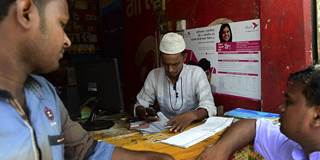Because traditional financial services are not designed for small depositors and borrowers, several non-traditional models have been able to scale up rapidly in this untapped market. But, without a strategic policy roadmap to guide further financial-technology development, these models could hit a wall.
CAMBRIDGE – Because traditional financial services are not designed for small depositors and borrowers, several non-traditional models have been able to scale up rapidly in this untapped market. But, without a strategic policy roadmap to guide further financial-technology (fintech) development, these new “connector” models will remain limited in terms of the services they can provide.
In Kenya, the success of M-Pesa, a mobile payments app, has been nothing short of transformational. It took PayPal two NASDAQ listings and almost two decades operating in the world’s largest economy to reach 188 million active customers and $282 billion in annual payments. Although M-Pesa has been operating for less than a decade in a much lower-income market, it had nearly 17 million active users conducting more than $50 billion in cashless transactions last year.
Similarly, bKash now dominates the payments system in Bangladesh to such a degree that “bKashing” has become common Bengali parlance, just as “Xeroxing,” “Hoovering,” and “Googling” are in English.

CAMBRIDGE – Because traditional financial services are not designed for small depositors and borrowers, several non-traditional models have been able to scale up rapidly in this untapped market. But, without a strategic policy roadmap to guide further financial-technology (fintech) development, these new “connector” models will remain limited in terms of the services they can provide.
In Kenya, the success of M-Pesa, a mobile payments app, has been nothing short of transformational. It took PayPal two NASDAQ listings and almost two decades operating in the world’s largest economy to reach 188 million active customers and $282 billion in annual payments. Although M-Pesa has been operating for less than a decade in a much lower-income market, it had nearly 17 million active users conducting more than $50 billion in cashless transactions last year.
Similarly, bKash now dominates the payments system in Bangladesh to such a degree that “bKashing” has become common Bengali parlance, just as “Xeroxing,” “Hoovering,” and “Googling” are in English.